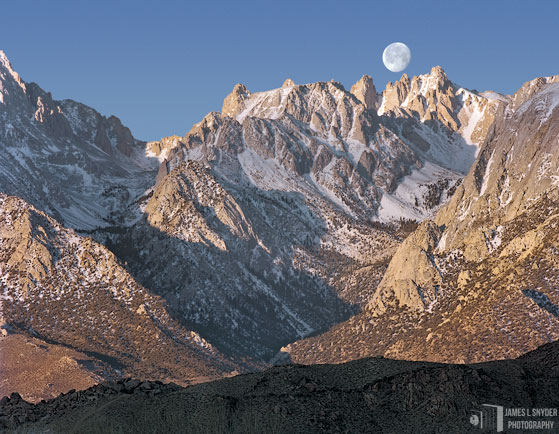

South Main Street (US 395), Lone Pine, Inyo County, CA, 3/6/2007
At sunrise three mornings after a full moon, I prepared my camera by the side of South Main Street (U.S. Highway 395) in Lone Pine, CA. I aimed my longest lens west at the striking Corcoran Pinnacles and watched the moon set behind them. This row of granite teeth or spires is also known as Corcoran Crest, Corcoran Ridge, and Comb Ridge. We're standing at an elevation of 3,700 feet above sea level in eastern California's Owens Valley and looking at some of the tallest peaks in the Sierra Nevada Mountains. The mountain at far left, with elevation 14,032 feet is Mt. Langley, named after American astronomer and physicist Samuel Pierpont Langley (1834-1906). Mt. Mallory (13,851 feet) is the distant peak at far right, named in memory of George H. Leigh Mallory of the British Alpine Club, who was lost on Mt. Everest in 1924. The deep gap between pinnacles immediately left of and below the moon is called North Notch. Forming the left wall of North Notch is Mt. Corcoran (13,714 feet), whose namesake was William Wilson Corcoran (1798-1888), American banker, philanthropist, and art patron. The tip of Sharktooth pinnacle (13,648 feet) is barely visible to the left of Mt. Corcoran. The prominent peak just to the right of the moon is Mt. LeConte (13,936 feet), the tallest spire on the ridge. The peak was named in 1895 for Joseph LeConte (1823-1901), the first professor of Geology and Natural History at the University of California at Berkeley from 1869 to 1901. LeConte maintained an enduring friendship with Scottish-born American naturalist John Muir (1838-1914), and helped found the Sierra Club in 1892. My hero, American wilderness photographer and climber Galen Rowell (1940-2002) made the first traverse of the Corcoran Crest to the summit of Mt. LeConte in August of 1970. He had been intrigued by this fantastic row of spires at the head of Tuttle Creek. Tuttle Creek Canyon is the enormous V-shaped glacially carved hollow beneath the Corcoran Pinnacles, and is formed around the north and south forks of Tuttle Creek in the John Muir Wilderness area of Inyo National Forest. In the shade at the very bottom of the photograph are the Alabama Hills, which were named during the Civil War in 1862 by Southern sympathizers, commemorating the victories of the Confederate ship CSS Alabama.